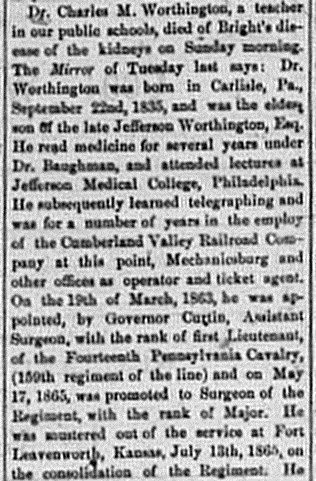A survivor of the infamous Libby Prison, Charles McClure Worthington was a man of many occupations; a telegraph operator on the Cumberland Valley Rail Road, a Civil War surgeon, a druggist, and finally, a Carlisle school teacher.
Charles M. Worthington was born in Carlisle on September 22, 1835, the eldest son of Ann and Jefferson Worthington, a painter and County Commissioner. Worthington was educated in the Carlisle schools and read medicine with Dr. Baughman. Later he attended lectures at Jefferson Medical College in Philadelphia.1
For some reason Worthington did not practice medicine but instead worked as a ticket agent and telegraph operator for the Cumberland Valley Railroad.2 On October 27, 1863, Worthington married Miss Anna M. Cornman at her father’s residence in Carlisle, but he would spend much of the next two years far from home.
In March 1863, Governor Curtin appointed Worthington an Assistant Surgeon of the 14th PA Cavalry, 159th Regiment.3 During the war he served under General W. W. Averill and accompanied him “in all his dashing raids in the Valley of Virginia,” according to Worthington’s obituary. “He was captured by the Confederates at Rocky Gap, Greenbrier White Sulphur Springs, Virginia and taken to Libby Prison in Richmond.”4 Worthington survived his internment at Libby Prison and was mustered out of the army at Fort Leavenworth, Kansas on July 13, 1865.
When Worthington returned to Carlisle, he entered the drug business with his father-in-law Ephraim Cornman, Esq. By 1870, Worthington and his wife were the parents of two children; son Raymond, aged four, and one-month-old Emma.5 Worthington was doing well enough financially to employ a 16-year-old servant girl.6
In 1875, Worthington and his father-in-law dissolved their business partnership and Worthington took a position as a teacher for the Carlisle schools. The 1877 Directory of Carlisle listed his occupation as a teacher and his home at 59 ½ West Pomfret Street. Suffering from Bright’s disease, his health got steadily worse.
Worthington died on October 13, 1878 and was buried in Carlisle’s Old Graveyard. Several School Board Directors and fellow teachers acted as pall-bearers and escorts, and many of his pupils and fellow citizens attended the funeral.7 With a 12-year-old son to raise, and a living to earn, his widow, Annie M. Worthington, took a live-in-job as a teacher at the newly established Carlisle Indian Industrial School.8
In September 1883, Annie’s son, Raymond, achieved his dream of attending West Point,9 but his health suffered. He was forced to take leave from West Point and return home where he was confined to his bed. He died of consumption on February 4, 1887 in his mother’s home at the Indian School. He was twenty one. His obituary stated that “had he been well, he would have graduated with his class in June.10 Annie continued to teach at the Indian School, and died on May 21, 1896 at the age of 56. She is buried in Carlisle’s Old Graveyard with her husband and children.

